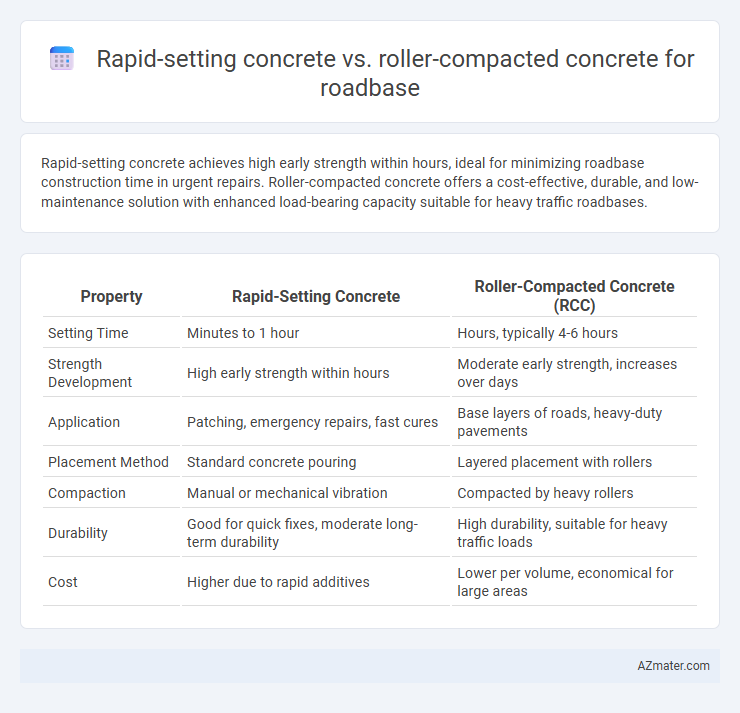Rapid-setting concrete achieves high early strength within hours, ideal for minimizing roadbase construction time in urgent repairs. Roller-compacted concrete offers a cost-effective, durable, and low-maintenance solution with enhanced load-bearing capacity suitable for heavy traffic roadbases.
Table of Comparison
| Property | Rapid-Setting Concrete | Roller-Compacted Concrete (RCC) |
|---|---|---|
| Setting Time | Minutes to 1 hour | Hours, typically 4-6 hours |
| Strength Development | High early strength within hours | Moderate early strength, increases over days |
| Application | Patching, emergency repairs, fast cures | Base layers of roads, heavy-duty pavements |
| Placement Method | Standard concrete pouring | Layered placement with rollers |
| Compaction | Manual or mechanical vibration | Compacted by heavy rollers |
| Durability | Good for quick fixes, moderate long-term durability | High durability, suitable for heavy traffic loads |
| Cost | Higher due to rapid additives | Lower per volume, economical for large areas |
Introduction to Roadbase Concrete Technologies
Rapid-setting concrete offers accelerated curing times, enabling faster construction and early load-bearing capacity, crucial for time-sensitive roadbase projects. Roller-compacted concrete (RCC) provides high strength and durability through a zero-slump mixture compacted with rollers, optimizing cost and equipment efficiency for large-scale roadbase applications. Both technologies enhance roadbase performance, with rapid-setting concrete prioritized for speed and RCC favored for structural resilience and economic scalability.
Overview of Rapid-setting Concrete
Rapid-setting concrete offers accelerated strength development, reaching functional load-bearing capacity within hours, making it ideal for emergency repairs and fast-track road construction projects. Engineered with specialized cementitious materials and chemical admixtures, it minimizes downtime by enabling early traffic reopening and reduces formwork removal time. Its high early strength and durability enhance pavement longevity in roadbase applications compared to traditional concrete mixes.
Key Features of Roller-compacted Concrete
Roller-compacted concrete (RCC) for roadbase features a no-slump consistency allowing for rapid placement and compaction using standard asphalt equipment, which accelerates construction timelines compared to traditional concrete mixes. RCC exhibits high compressive strength, enhanced durability, and excellent load-bearing capacity, making it ideal for heavy-traffic roadbase applications. Its economical use of cement and aggregate combined with reduced curing requirements offers significant cost savings and sustainability benefits over rapid-setting concrete alternatives.
Comparative Mix Design and Composition
Rapid-setting concrete features a high cement content combined with fast-reacting admixtures, leading to quick strength gain within hours, ideal for urgent repairs; its mix design emphasizes low water-to-cement ratios and chemical accelerators to reduce setting time. Roller-compacted concrete consists of a drier, leaner mix with minimal fine aggregates and lower cement content, allowing compaction by rollers to achieve density and strength, favoring cost-effective, large-scale roadbase applications. The primary compositional difference lies in water content, admixture use, and aggregate gradation, affecting workability, curing time, and structural performance in roadbase layers.
Construction Methods and Equipment Differences
Rapid-setting concrete for roadbase requires specialized mixing equipment to achieve fast curing times, allowing for quicker traffic opening and reduced downtime. Roller-compacted concrete (RCC) is placed using heavy-duty paving machines and compacted with vibratory rollers, resembling asphalt construction methods for improved density and strength. The key equipment difference lies in RCC's use of standard asphalt paving and rolling machinery, while rapid-setting concrete necessitates rapid-mix batch plants and precise timing in placement.
Setting Time and Early Strength Development
Rapid-setting concrete for roadbase achieves initial set within 30 to 60 minutes, enabling early traffic loading and minimizing construction delays. Roller-compacted concrete (RCC) typically sets within 3 to 4 hours, offering moderate early strength but requiring extended curing for full load capacity. The accelerated setting time and higher early compressive strength of rapid-setting concrete make it preferable for projects demanding fast turnaround and early serviceability.
Durability and Performance in Road Applications
Rapid-setting concrete exhibits high early strength development and superior resistance to chemical attacks, making it ideal for quick repairs and high-traffic roadbase applications requiring minimal downtime. Roller-compacted concrete (RCC) offers enhanced durability due to its dense, low-slump composition, enabling excellent load distribution and resistance to heavy axle loads and freeze-thaw cycles. Comparative studies indicate RCC provides longer service life and reduced maintenance costs in large-scale roadbase projects, while rapid-setting concrete suits urgent, localized repairs where early serviceability is critical.
Cost Analysis: Material and Installation
Rapid-setting concrete typically incurs higher material costs due to specialized additives accelerating curing times, but it significantly reduces installation labor expenses by enabling faster project completion. Roller-compacted concrete (RCC) offers lower material costs with conventional cementitious components and minimal additives, while installation expenses remain moderate because of streamlined paving techniques using heavy equipment. Overall, rapid-setting concrete favors projects prioritizing urgent timelines despite elevated material prices, whereas RCC provides cost-effective solutions for large-scale roadbase applications with balanced material and installation costs.
Sustainability and Environmental Impact
Rapid-setting concrete offers reduced curing times, significantly lowering construction emissions and allowing faster project completion, which minimizes environmental disruption. Roller-compacted concrete (RCC) utilizes a dry mix and less water, decreasing carbon footprint and improving resource efficiency in roadbase applications. Both materials support sustainable infrastructure by enhancing durability and reducing maintenance frequency, but RCC's lower cement content provides a notable advantage in carbon reduction.
Best Use Cases and Recommendations
Rapid-setting concrete offers fast strength gain, making it ideal for emergency road repairs and projects requiring minimal downtime. Roller-compacted concrete provides high durability and cost-effectiveness for large-scale roadbase applications such as highways and heavy-traffic industrial pavements. For optimal results, use rapid-setting concrete in time-sensitive urban repairs and roller-compacted concrete for long-lasting, heavy-load infrastructure projects.

Infographic: Rapid-setting concrete vs Roller-compacted concrete for Roadbase
 azmater.com
azmater.com